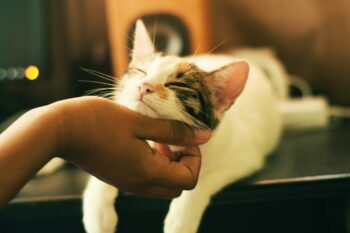Buy a new litter box. You scrub it, you bleach it, you let it dry in the sun, but it still looks a little worn around the edges and probably smells too. Time for a new one! But before you run out and buy the newest, fanciest model, think about whether any of your cat’s habits have changed. Since she’s getting older and creakier, she may have started having trouble climbing in and out of the box. Solution: a box with lower sides. Or has she gained a little weight, making it harder for her to turn around in the box? A roomier box would sure make life more comfortable for her. Just remember, with litter boxes, your cat’s preferences should always come first.
Improve your cat’s diet. Because cats are what’s known as obligate carnivores (meaning their system is entirely geared to digest meat and they cannot survive on a vegetarian diet), the higher their diet is in protein, the better (think Atkins for cats). Look at the list of ingredients for cat foods to see if high-quality protein sources, such as chicken, lamb, or beef, are included in the first four ingredients. Once you find the right diet, you’ll be impressed by the change in your cat’s fur as it becomes softer and shinier. As long as you’re at it, try putting an extra water bowl in a convenient location in the house — it’ll help keep your cat hydrated.
Take your cat for a checkup. We know she hates going to the veterinarian. But it’s for her own good. Get her teeth checked for potentially painful dental conditions and have the veterinarian examine any little funny bumps or swellings that may have cropped up on her body. Get blood tests for diabetes and kidney problems. And remember, your cat can’t explain her symptoms, so it’s up to you to know her well enough to describe anything unusual to the veterinarian. Afterward, you can both treat yourselves with a well — earned interactive game.
Have a huge catnip party. Go all out and scatter piles of catnip on the kitchen floor. To add to the fun, wait a few minutes, then toss a brand-new mousie toy to your goofy kitty to play with madly. Catnip, which temporarily lights up the pleasure centers of a cat’s brain (sort of in the same way a huge chocolate sundae does for us), can greatly reduce the stress of indoor living. Since the effects are temporary (about 15 minutes or so), it’s not addictive. Another fun trick is to “marinate” toys in a jar filled with catnip.
Help your cat’s friends. I bet that your cat would definitely appreciate it if you did a little something to help her species. Donate something to help your local shelter or animal rescue group, whether it’s a soft old blanket to comfort some elderly stray in his cage, a few well-chosen toys to entertain cooped-up cats, office equipment for the hardworking human staff, or volunteer time to help clean cages and groom cats. If nothing else, cold hard cash is always appreciated by underfunded shelters.







